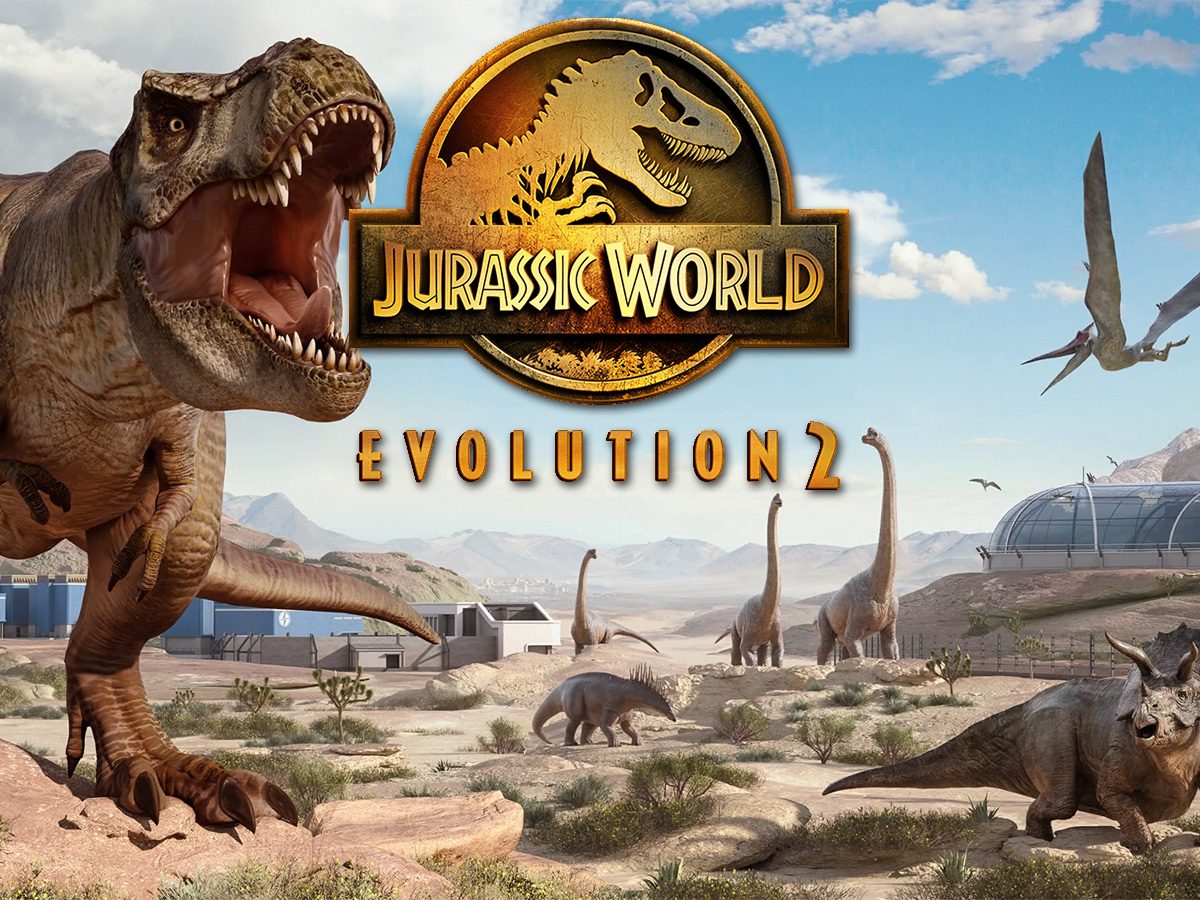What Is Jurassic World Evolution 2?
Jurassic World Evolution 2 is, perhaps unsurprisingly, the sequel to the popular Jurassic World Evolution. As with all Jurassic franchise games, you’ll find yourself breeding dinosaurs, building habitats for them to live in, and containing them when the inevitable happens and life, uh, finds a way to break out and cause carnage. Given that the game’s main storyline is set after the events of Jurassic World: Fallen Kingdom, spoilers for that film will be found in this review.
Please note: This post contains affiliate links.
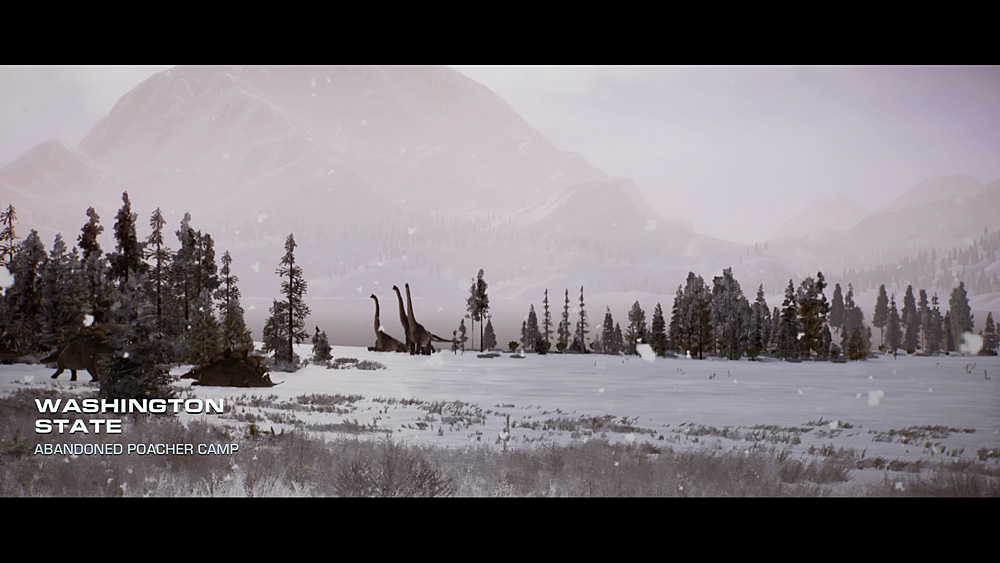
Age Rating
Jurassic World Evolution 2 (which I will now mostly refer to as JWE2) is rated ESRB Teen (for mild blood and violence) and PEGI 16 (for violence). Given this is a park simulation/management game, the violence found here is between the dinosaurs and when rampaging carnivores attack humans. There is also occasional sabotage where disgruntled employees and other groups will intentionally knock out park systems, leading to escaping dinosaurs and death/injury to humans. Injured dinosaurs will appear with noticeable red wounds, and you will occasionally find a dead dinosaur in your park.
Personally, I would have no qualms about letting my twelve-year-old play, and would probably have allowed him to play several years ago as well, but suitability will, of course, depend on the individual child.
Available Formats
Jurassic World Evolution 2 is available on:
- Microsoft Windows (Steam), (Epic Games Store)
- PlayStation 4
- PlayStation 5
- Xbox
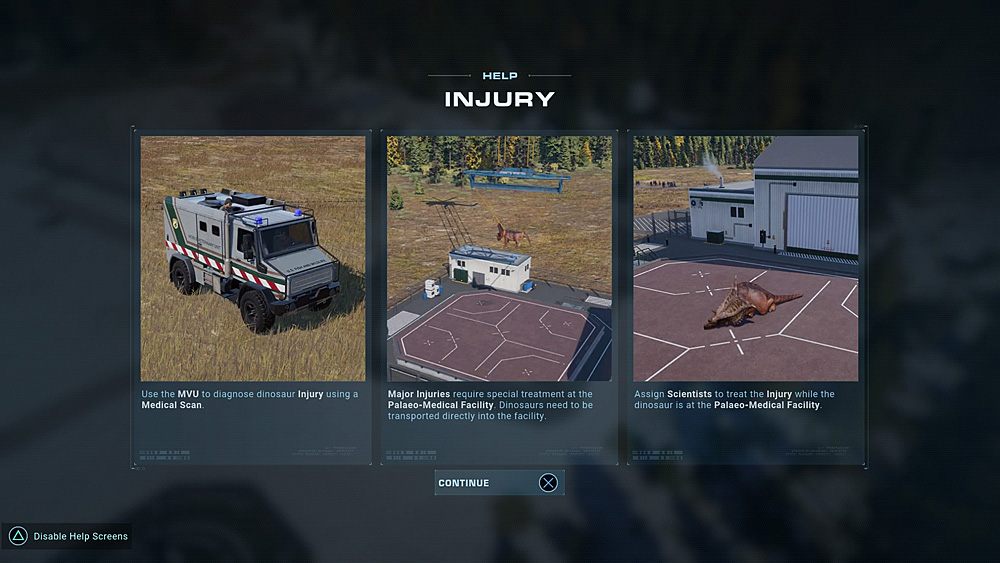
System Specifications:
Minimum PC specs:
- Requires a 64-bit processor and operating system
- OS: Windows 10 64bit (min version 1809)
- Processor: Intel i5-4590/AMD FX 8370
- Memory: 8 GB RAM
- Graphics: (4GB VRAM) NVIDIA GeForce GTX 1050Ti (Legacy GPU: GeForce GTX 960) / AMD Radeon RX 470
- DirectX: Version 12
- Storage: 14 GB available space
Recommended PC Specs:
- Requires a 64-bit processor and operating system
- OS: Windows 10 64bit (min version 1809)
- Processor: Intel i7-5775C/AMD Ryzen 5 1500X
- Memory: 12 GB RAM
- Graphics: (6GB VRAM) NVIDIA GeForce GTX 1070 / AMD RX 570 (8GB)
- DirectX: Version 12
- Storage: 14 GB available space
Jurassic World Evolution 2 Trailer
Jurassic World Evolution 2 Gameplay
JWE2‘s gameplay is largely the same as its predecessor in many respects; you’ll create buildings and connect them with paths while ensuring an adequate power supply is in place; breed dinosaurs and tend to their environmental needs; conduct research on buildings, medicines, and upgrades; send out expeditions to uncover fossilized DNA from around the world; and occasionally deal with disasters such as storms and sabotage, all while trying to turn a profit and keep your park guests happy (and uneaten). As such, I’ll primarily focus this review on what’s new in this sequel.
Of course, you’ll have Dr. Ian Malcolm along for the ride wherever you go making witty and acerbic comments about whatever you’re up to. Also back to provide narration and assign tasks are Claire Dearing (voiced by Bryce Dallas Howard), Dr. Henry Wu (voiced by B. D. Wong), and many familiar faces from the first game such as Cabot Finch, Owen Grady, Dr. Kajal Dua, and George Lambert.
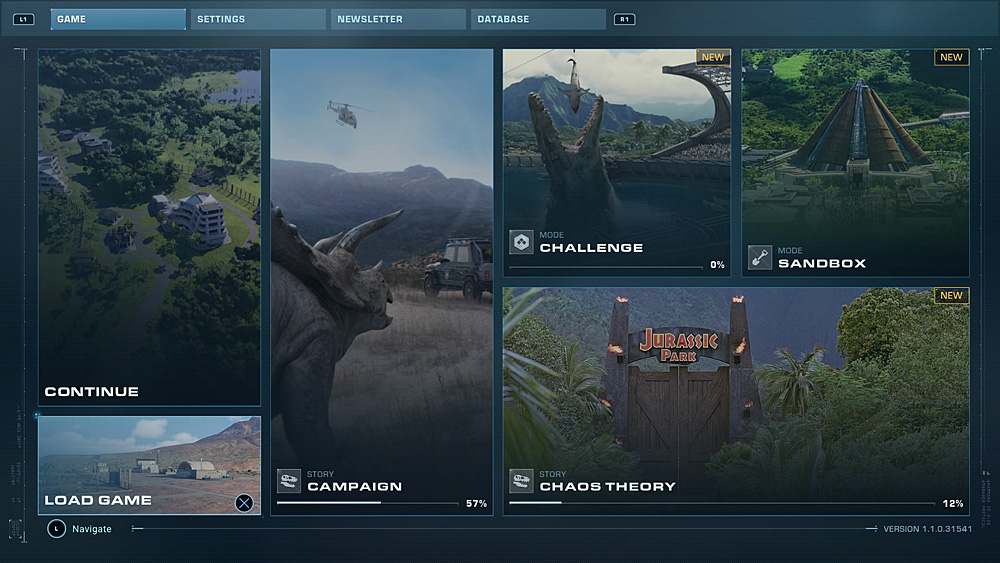
Game Modes
The game features four modes and you’ll be able to jump into any one of them right from the start, although you will find that many locations, buildings, and dinosaurs are locked at the beginning and will require you to meet certain requirements in order to unlock them.
Story: Campaign
The Campaign Mode is probably JWE2‘s main game mode, and almost certainly where you’ll want to begin playing. Here you’ll find yourself picking up where Fallen Kingdom left off: the dinosaurs have escaped and are now roaming wild across America. This is where JWE2 really stands out from other Jurassic franchise games because you’ll get to play across a variety of landscapes, not just the tropical climates of Costa Rica. Working with the Department of Fish and Wildlife, you’ll begin in Arizona helping to contain a number of wild dinosaurs—you can check out my complete playthrough video of the entire first level in Arizona on my YouTube channel—before moving on to clean up a dinosaur poacher camp along the snowy Canadian border, and then setting up a hub in Pennsylvania.
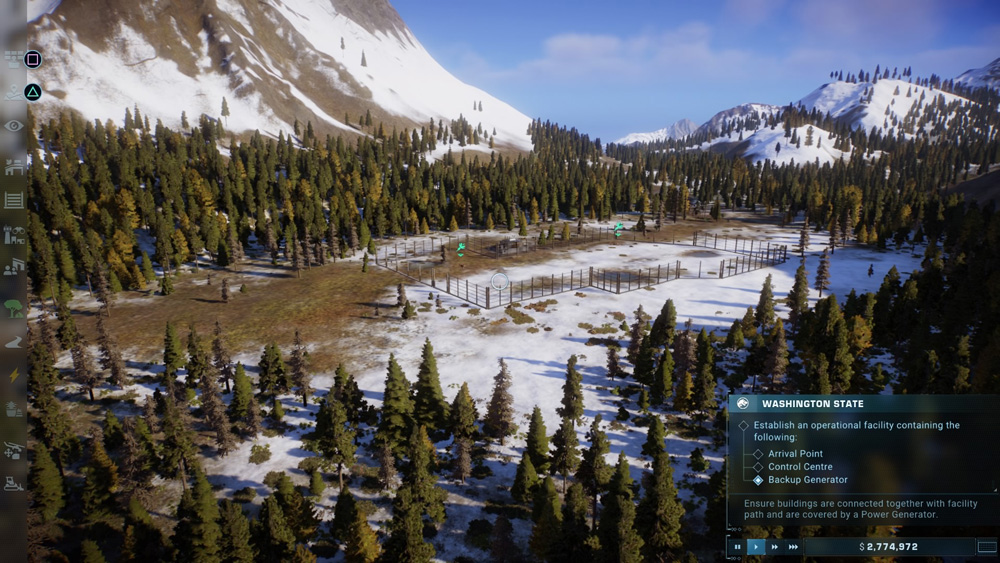
Campaign mode begins as a tutorial and gradually gives you increasing control, but that sense of tutorial never quite goes away. Every stage of the Campaign Mode felt highly controlled with limited flexibility and simplified gameplay, which meant I flew through each stage at record speed. After only a couple of hours of play, I exited to the main menu and was shocked to find I was already 57% of my way through the campaign. I suspect this is largely because the storyline of this campaign will act as filler content between the Fallen Kingdom and Dominion films and so not much actual plot can be included, but it did feel like a bit of a letdown.
Story: Chaos Theory
Chaos Theory very quickly became one of my two favorite gameplay modes in JWE2. This mode is broken up into six parts, one for each of the Jurassic films released so far, and you can choose to tackle them in any order. Each part presents a “What If…” scenario based on the events of that film: What if Jurassic Park San Diego became a reality? What if you built Jurassic World with Simon Masrani? Here, you’ll work through tasks but also be able to build flexibly and create your own vision of how these classic parks could have been.
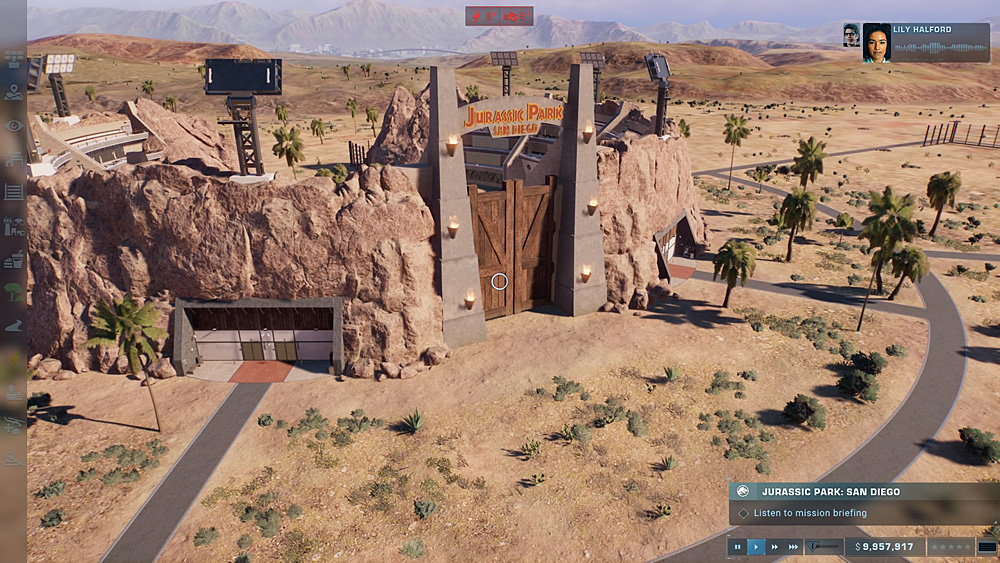
While Chaos Theory mode is largely located on Isla Nublar and Isla Sorna, it travels through time, letting you play in the original 1993 park as well as the more up-to-date versions from 2015 onwards. There’s a huge amount of variety in this one game mode and it will probably take me weeks of playing to explore all of it.
Challenge
Five Challenge Modes are available here beginning with Canada and allowing you to eventually unlock challenges in Germany and the UK as well as multiple locations within the US. Unlocking new locations is done by earning cumulative stars in previous locations. In Challenge Mode, you’ll attempt to build a five-star park and beat the par time in doing so. Each location allows you to set a difficulty level from Easy (par time two hours and 30 minutes) through to Jurassic (par time a whopping nine hours). The higher the difficulty, the less starting cash will be available and you’ll be faced with higher outgoings and more demanding staff too. When in Challenge Mode you’ll have significant flexibility to build your parks the way you want, but if you want to beat that par time, you’ll need to keep focused and plan a solid strategy.

Sandbox
The final game mode is Sandbox and here, as is typical in sandbox modes in other games you’ll have unlimited cash with which to build your dream park. Once again, you’ll start out with only Canada unlocked but eventually you can add another eight sandbox locations by earning stars in the Chaos Theory and Challenge modes. These locations include a variety of climates (tropical, temperate, alpine, and desert among them) and differing sizes of the buildable area so you can choose to spread out across a vast area or challenge yourself to pack the ultimate park into a small space.
New Game Features
Dinosaurs and Wellbeing
The base game of JWE2 has nearly 50 dinosaurs available to research and breed including all your favorites from the films, and many you may very well not have heard of—Muttaburrasaurus anyone? Hatching ground-based dinos works almost exactly the same as before except you’ll initially synthesize a batch of eggs then get to choose which (if any) to grow into new dinos after checking out any potential problems, such as an increased likelihood of aggression or poor resistance to disease. Aquatic creatures and flying ones get their own separate hatcheries that you’ll need to research first as well as buying the special habitats they need to survive.
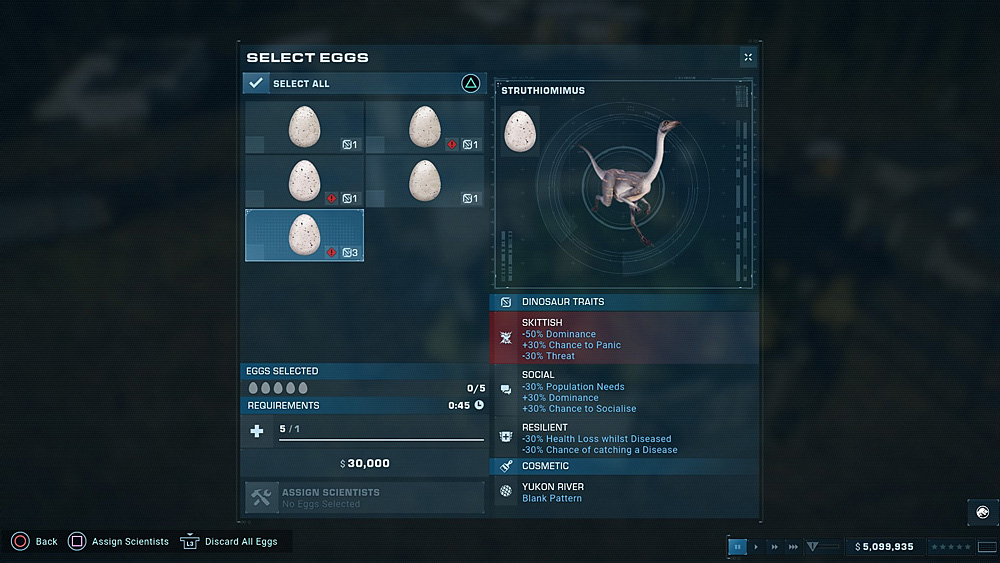
Each dinosaur species requires certain environmental conditions in order to be content and not start attacking the fences and eating the guests. Every species will require access to water and food. Carnivores will need meat or live prey dispensers while herbivores will require specific forms of plant life. Other requirements will also need to be met for each specific species: T-Rex, for example, needs sand and forest areas in its enclosure. Each dinosaur species will also need to be in a certain size group too; large carnivores are usually content alone or with a single companion, while most herbivores such as gallimimus need to be in a large herd. Some species can be combined together in a single paddock, but mixing the wrong types will result in carnage and you’ll need to watch those environmental factors too—a species that wants a high amount of forest probably won’t live happily with one that prefers wide-open spaces. Don’t be fooled into prioritizing the needs of your large carnivores either, an unhappy triceratops running wild will cause significant damage to your fences and leave you with hundreds of terrified guests which isn’t good for business.
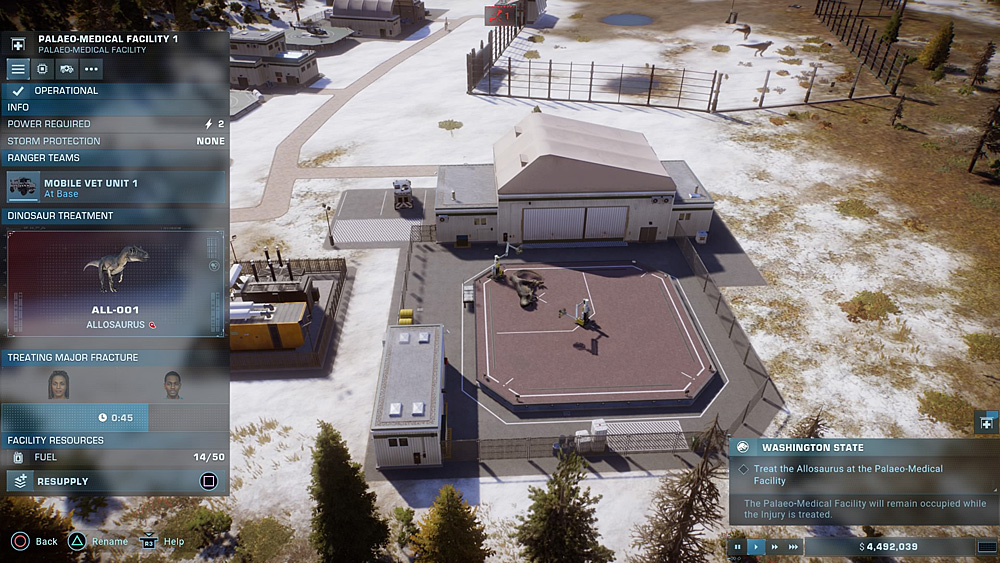
One thing I particularly liked about this new edition of the game is that it seems to have a stronger focus on the welfare of the dinosaurs. A Paleo-Medical facility is available with a veterinary team on standby to head into the field and perform scans or bring in injured dinosaurs for more invasive medical procedures. I also appreciated the ranger stations. These small items can be placed into each paddock and assigned to a ranger team who will then regularly visit and perform status checks on the dinosaurs nearby, assessing their happiness, health, and general wellbeing. This makes it much faster to spot unhappy dinos before they start causing carnage. A dinosaur that hasn’t been checked for a while will have a small symbol showing binoculars pop up above them, and you can manually assign a ranger team to check in on them.
Building and Customization
It’s not only your dinosaurs that will need looking after, your human visitors will too. You’ll need to fill your park with amenities including shops, dining, restrooms, and hotels to keep them satisfied, as well as building viewing areas to let them get a good look at the dinosaurs they’ve paid to see. Emergency Shelters will also need to be strategically placed around your parks, just in case…
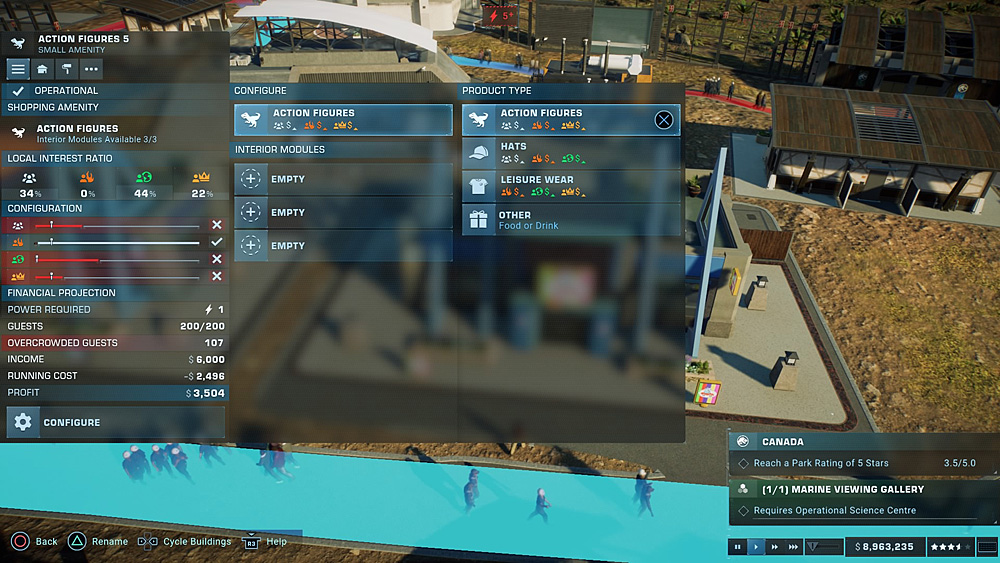
Many of the buildings are highly customizable with hundreds of combinations available between overall building style, roofs, entrances, and decorations—and that’s before we even get to choose between practically infinite color options! Check out this short video on my YouTube channel to get an idea of how much variety there is to choose from. The interiors are also customizable, although that’s where I found my biggest difficulty across JWE2 gameplay. Each amenity building (that’s food, drinks, and shopping) will show a Local Interest Ratio split across four areas: blue, red, green, and gold. For example, the shop I am looking at as I type this shows 36% blue, 0% red, 44% green, and 19% gold, but these numbers will constantly adjust up and down. You can then configure your shop by choosing from different product types that will adjust the configuration bars below these numbers. Adding in extra Interior Modules such as a fish tank, sunglasses stand, fossil display, or fountain will further adjust the bars. However, at no point has the game ever explained what these bars are, what the colors relate to (the red appears to show a flame, the green might be a planet, and the gold is a crown), or how important any of this is. This has left me wildly guessing or otherwise ignoring it altogether because there is almost always a more pressing concern happening elsewhere in the park.
Staff
One of the most noticeable differences between JWE2 and its predecessor is staffing. In the original JWE game, staffing was largely automatic. If you added an Expedition Centre, you gained a Dig Team to go out and collect your fossils. Then, when they returned with their discoveries, another team extracted the DNA while the Research Team researched new additions for the park. In JWE2 you’ll have to manage a pool of individual staff members. Building Staff Centers will allow you to recruit new scientists from an ever-changing and diverse pool (you can also fire existing staff to free up space), but be careful who you choose. Each staff member will have a skill level across Logistics, Genetics, and Welfare, and you’ll need to consider these when hiring. Tasks such as researching a new building or conducting an expedition will have a requirement across the three skill sets, and if you don’t have scientists with high enough skills, you won’t be able to complete that task. The scientists also come with different salary requirements and traits such as decreasing the time taken for tasks, reducing costs, and increasing skill levels.
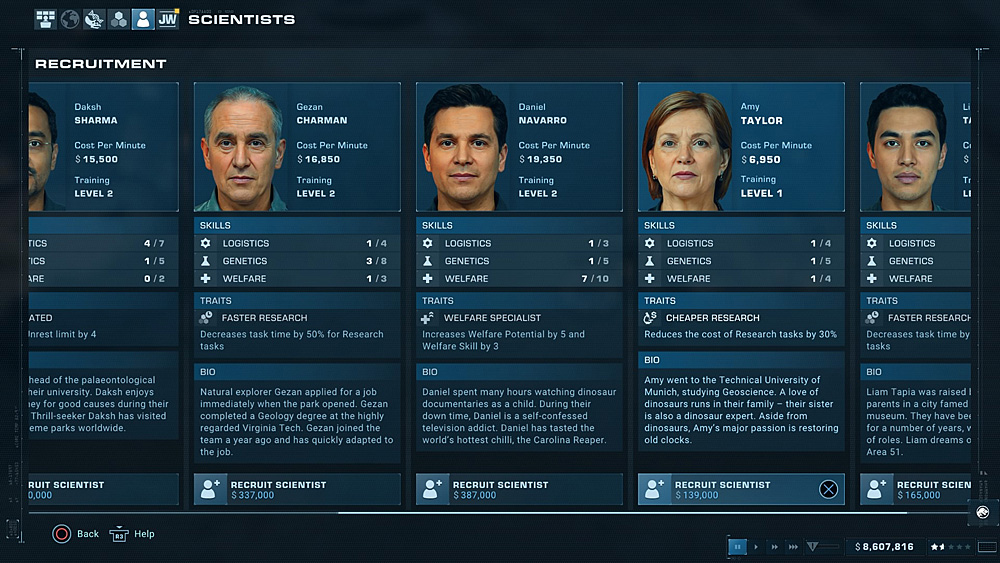
There are two other new elements to deal with when it comes to your staff. First, you’ll need to send them to rest regularly, or else you’ll risk them becoming unhappy and sabotaging your hard work. Secondly, there’s training. Not only will your staff have a current skill level, but they’ll also have a higher one available through training. It might be worth hiring a less skilled but cheaper scientist and then training them to improve their levels rather than hiring an expensive but higher-skilled individual, it’s up to you.
Other Features
One particularly helpful new feature in JWE2 is time management. The game allows you to double or triple the rate of time passing which is very helpful if you have to wait for a piece of research to be completed or an expedition team to return. Conversely, you can also pause the game if ever you’re feeling overwhelmed and need a few moments to plan your next move.
One big change is the immediate inclusion of flying and aquatic species and the new buildings required to hatch and look after them. Flying species were included as DLC in the first game, but no aquatic creatures were ever seen so this is a big, much-anticipated feature. JWE2 allows you to build lagoons, as seen in Jurassic World, and aviaries of the type seen in Jurassic Park 3. The base game comes with six marine reptiles and six flying reptiles with the deluxe edition offering one more of each.
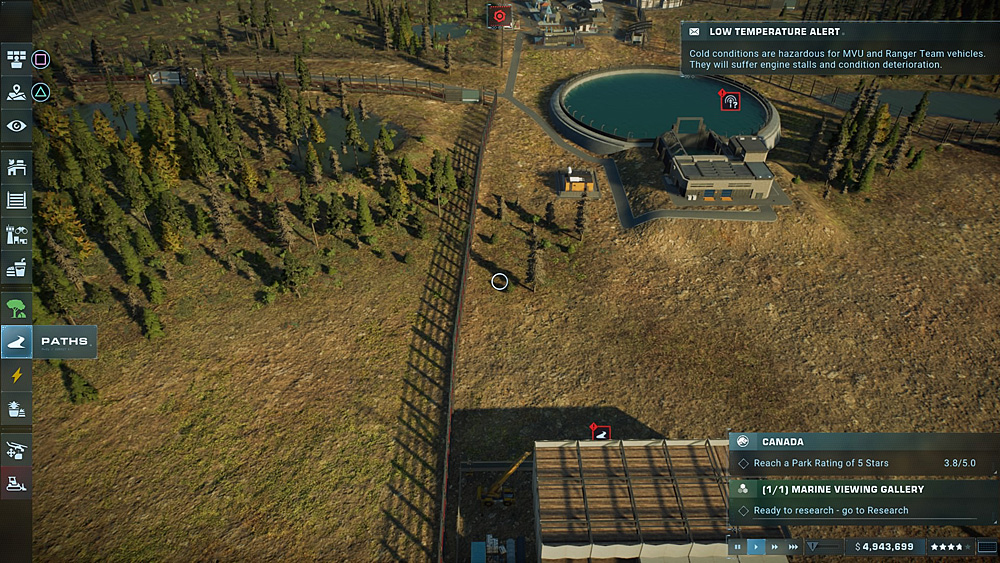
The process of hatching dinosaurs has also been vastly improved. This now takes place in two stages and allows you to select from a choice of embryos after checking out any potential issues, meaning you can hatch multiple dinos at once—a blessing when attempting to breed herds of herbivores who quickly become lonely. Finally, when ready for release, an option to immediately airlift your dinosaurs is available in JWE2, solving the first game problem of having to release dinosaurs then immediately tranquilize and airlift them around the park if you didn’t want enormous hatcheries attached to every paddock.
Expansions and In-Game Purchases
There are currently no expansions or in-game purchases available, however, you will have the choice to buy either the Standard or Deluxe Edition of the game. The Deluxe upgrade pack is also available separately if you happen to buy the wrong one, and it contains five extra prehistoric animal species, six different building signs, and three vehicle skins.
The original edition of the game now has eight expansions/content packs available, and with the release of Jurassic World: Dominion planned for June 2022, I’m sure there will be lots of extra content coming in the future.
Jurassic World Evolution 2 Verdict
The first Jurassic World Evolution game got me through the first Covid lockdown after I downloaded a sale copy on my PS4, so right from its initial announcement, I was sure I was going to love Jurassic World Evolution 2, and the game did not disappoint.
Fans of the original (and also other Jurassic franchise park building games, or just theme park management games in general) will find a lot to love here. There are all your typical theme park management features such as placing enough restrooms in busy areas, laying out your park in practical yet aesthetically pleasing ways, and turning a healthy profit, but also zoo management, research programs, and scientific expedition to handle. Yes, you could easily retitle this as Micro-Management: The Game, but for those of us who enjoy this kind of thing, JWE2 does all of it exceptionally well.
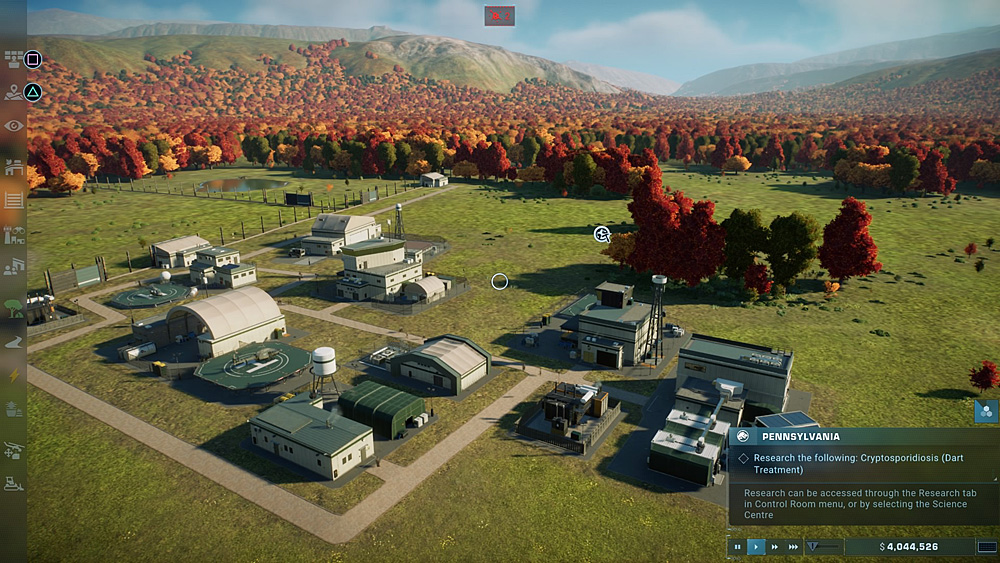
The game itself is, as I said earlier, broadly similar to the first JWE game, but there’s definitely enough new content here to justify picking up the new edition. Chaos Theory mode alone is a fantastic addition that brings in new locations and ideas from across the entire Jurassic franchise, catering to both those who want new, up-to-date scenarios based on the latest films, and also those seeking a nostalgia trip back to the ’90s, and while the Campaign Mode is a little short and simple, the decision to place it after the events of Fallen Kingdom opens up a whole new world of environments and associated challenges that add some real variety to an established concept.
JWE2 also fixes several issues from the previous game. The first game’s obsession over contracts was a constant thorn in my side—you had to keep a constant watch on your reputation, making sure you weren’t favoring one department’s contracts over the other two or else you risked sabotage in your parks (the Park Security department deliberately sabotaging the gates on the velociraptor paddock never did make much sense). JWE2 does keep the monthly contracts, at least in some game modes, but they no longer have the same huge impacts within the game and are more of a fun addition now than a bugbear. The ability to immediately airlift newly hatched dinos from the hatchery is an enormous improvement that makes it much easier to design pleasing parks.

My biggest problem with JWE2 was regarding staff management. Where in the first game you simply assigned a Dig Team to an Expedition, or a Research Team to conduct research, in JWE2 you work from the same pool of scientists for everything. This leads to ridiculous, immersion-breaking situations where you cannot treat an injured dinosaur because you need a scientist who is currently out on a fossil excavation dig, or you cannot research a new ride for your guests because your scientists are busy extracting DNA from a fossil. Even hatching new dinosaurs—previously a process that required clicking a single button—now requires individuals from that same pool of staff members to be assigned. Adding in their need for regular rest breaks means that any tasks involving assigning staff members to a job have become an exercise in frustration. Sure, you can partially solve the problem by building multiple Staff Centers and employing an excess of staff so you always have extra hands available, but this is a costly solution that won’t always work, especially at the beginning of challenges when money is often at a premium.
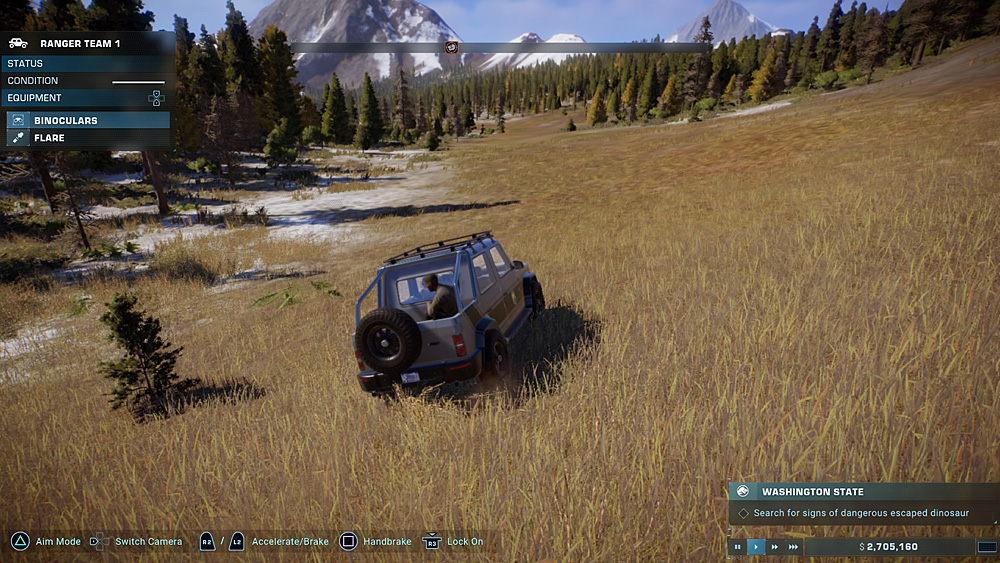
So, to sum up, Jurassic World Evolution 2 is a solid new edition of an already great game. The graphics are, once again, stunning with incredible attention to detail even though I was playing on an older generation console (PS4)—I can’t begin to imagine how it would look on a PC with a high-end graphics card—and the gameplay is easy to learn, even if it is a little obsessed with micro-management. I will admit that I can’t see this game dragging in too many new players. If you weren’t interested in or didn’t enjoy JWE then there’s not much that will sell you on this beyond tweaks to the gameplay experience. However, for those of us who love park building and management sims, JWE2 will be another incredible addition to our libraries and I am already looking forward to the inevitable expansions that will appear around the time of the next film.
GeekMom received a copy of Jurassic World Evolution 2 for review purposes.
